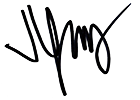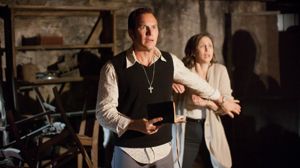This has been an exhausting few months, Mark. The heat. The humidity. The relentless and ruthless and utterly inhuman Hollywood spectacle. Indeed, the summer of 2013 may to prove to be a tipping point for popular cinema. The same way that the summer of '76 ushered in the era of the summer blockbuster, the summer of '13 may very well prove to be the ignominious end of the summer blockbuster.
So what a relief, in the middle of July, to see a movie that earns the discomfort of the audience--an effective, affecting, well-made horror flick.
The Conjuring isn't a great film. It doesn't do anything new. As it coasts along, the ticking-off of genre tropes feels almost self-conscious: the dog that refuses to enter the house, the precocious children preyed upon by unseen spirits, the creepy atonal music box, the flocks of kamikaze birds, and, most tired of all, the stringy-haired ghoul in a white nightdress crouched and crawling and pouncing.
But I found all that sameness easy to forgive. Ultimately, The Conjuring is an exercise in craft. As computer-generated imagery makes it possible for filmmakers to show us anything, and as that lack of boundaries continues to coopt the language of film, director James Wan, by demonstrating a concern for things like spatial logic and sequential clarity, feels like he's time-travelled to the present from a simpler, more comprehensible past. Sure, Wan operates in a strange tonal space (the bright-eyed earnestness of the ghost-hunters played by Vera Farmiga and Patrick Wilson, even as they spit out their absurd paranormal lingo, seems to be setting up a joke that never pays off), but he knows, unlike so many contemporary Hollywood filmmakers, how to tell a coherent visual story.
And that's where you come in, Mark.
Horror films are all about framing. And Wan's great gift as a filmmaker is that he's always pointing you and your camera in the right direction. Much of the tension in The Conjuring comes from our understanding of the way horror movies work, so, when a character is standing at the kitchen sink and the shot is framed to show the darkened window behind him, our attention - consciously or not - is drawn away from the action in the foreground and towards the empty space beyond, a black abyssal rife with possibility.
The danger and unease comes from those empty spaces. And Wan doesn't abuse them; no, he's conservative with his scares. There are only five or six in the course of the movie, but the anticipation and trepidation is continuous. You move your camera with purpose, with a stillness and patience that proves visceral feelings isn't exclusively a product of epileptic cinematography.
The story is all pretty standard stuff: young family moves into creepy house, finds a hidden cellar, doors creak, spirits possess. The cast, here, which, along with Wilson and Farmiga, includes Ron Livingstone and the rather terrific Lili Taylor, feels at times almost too good for the material, which contributes again to that sense of parody that, as the final scenes play out with no double-reverse metatextual trickery, is apparently accidental.
But perhaps it's all about how you frame it. Right, Mark? All these smugly self-referential, desperately self-serious summer movies I've been seeing this summer--maybe I was too busy looking past the action in the foreground to appreciate the simplicity of what was unfolding right in front of my eyes.
Sincerely,

Jared







